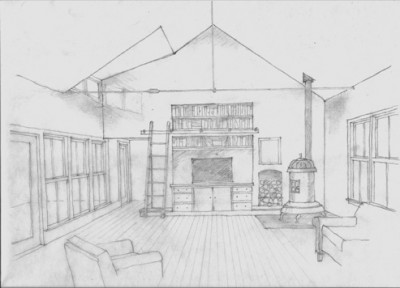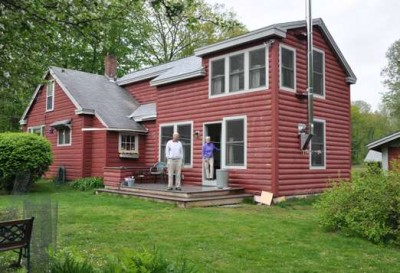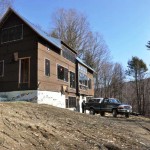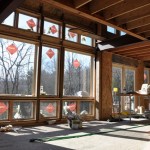Here is a quick architecty rendering of an interior space in a Southern VT cape addition we are working on. My intern is building a sketchup model from which I am rendering views such as this one. The project is complex enough that the 3-D aspect is neccesary to inform decisions. Having an intern is an eye opening experience. 40 productive hours per week gets a lot done and now I am worried about having enough work to keep him occupied!

links! Tim Prentice and Arthur Ganson
Art. Tim Prentice creates wickedly cool kinetic sculptures and Arthur Ganson creates glorious little mechanisms that do things. Enjoy
NESEA Workshop in Brattleboro
Yesterday I attended a workshop put on by NESEA, the Northeast Sustainable Energy Association entitled "Residential Retrofits for Energy Efficiency and Sustainability" by Larry Harmon. Usually I have to travel to Boston or Burlington to attend these which can be costly and time consuming so it was nice to have one a mile down the road from my offices. There was a lot of good information and Larry is an engaging speaker. The big things that I came away with were the reinforcement of what I have been learning about air sealing, venting, and insulation. 1-Seal completely before adding insulation. - Most contractors or architects probably don't grok the importance or level of thoroughness that is required here or realize the ramifications of doing a less than perfect job. It is not just about energy loss and heating bills. It is very much about how to make a house that will last 100 years or more. There was much discussion and many slides of imperfect air sealing jobs and how they acellerated rot and mold problems.
2-Don't ventilate your roof! That was so 80's and 90's. Now, ten or more years later we get to see the nasty ramifications of venting your roof. yuck!
There was a lot of other information which I may add in here over the next few days and some of which was rather techy involving cost analysis calculations and BTU's and therms, (oh My!)
What disturbed me as it often does at these events is the lack of local builders in attendance. Of the 10% of local builders who care about building science and sustainbility issues, very few will go much further than a subscription to JLC. I'm afraid that if I go out there and draw up plans for a house with an unvented roof or create specifications for enhanced air sealing, builders will simply refuse to follow the plans and convince the homeowners that the architect (me) is full of it. It's an issue that I'm sure a lot of other architects face as well. Although I suspect that 90% of architects don't really care about such things either.
Added the next day in response to a comment.
The presenter showed lots of slides of what happens when you leave a pencil size hole in the sealing of the attic before adding insulation. Basically air pressure turns it into an moisture laden air nozzle. All the moisture then condenses (dew point) on the sheathing and rots it through fast. Or it freezes on the underside of the sheathing then rains down on the insulation when it thaws. Ventilation compounds this pressure effect. The best method seams to be to bypass all these issues and spray the underside of the sheathing with closed cell foam which is what I specify on new construction and treat the attic as conditioned space. Loose fill cellulose or fiberglass batts lose much of their insulating value when exposed to air movement. Many independent tests in recent years have shown the temperature on the underside of the roof does not vary due to ventilation or no ventilation. There were also slides of what happens when insulation is added to an existing house attic that previously had no problems other than high heat bills. Suddenly the attic was cooler, the dew point moved to inside the attic and rot set in almost immediately. board sheathing holds up better than plywood which holds up better than osb.
I get the feeling that as building science matures, ventilated roofs will become a way for architectural historians to date houses to a specific time period in the late 20th century and early 21st century.
Kyu Sung Woo Architects - Putney House
 This is rather cool and local. Unfortunately when high end modern happens around here (rarely) it tends to have a big city architect behind it. I hope to change that. Although to be fair it was for the architect's own family.
This is rather cool and local. Unfortunately when high end modern happens around here (rarely) it tends to have a big city architect behind it. I hope to change that. Although to be fair it was for the architect's own family.
Ramblings
This may come off sounding like more of a personal diary entry but oh well. I have an intern arriving in a few weeks to work for me for the summer. (woot!) I am both exited by and nervous about the whole prospect. I need to write down a plan of action including my expectations. I have never before been an employer so to a great extent this is new territory for me. I have been in a supervisory role both in an office setting and as a carpenter and those situations always went well. (insert the usual grumbling about having to train someone who is relatively clueless but earning much more than me) I am hoping that the experience will be not only fun and profitable but force me to introduce more rigor into my working habits. If I have to be more organized for him then I will have to be more organized myself and I could always use more of that. I tend to be highly productive but disorganized in my workflow plans. I have lots of work but of course I am worried about it all drying up instantly. I would love to get another whole house commision or super cool, green and mod addition/renovation right now but will be fine if I don't. That's all, I have go to hang up all my awards and distinctions and diplomas etc. to properly impress and intimidate the intern when he arrives.
On a side note, I have been reading lots of case studies about architectural firm startups and have discovered that I am doing it all wrong!
A Past Project of the "Small-town Architect" Sort
 I stopped by the home of some former clients to look at possibilities for putting in a new floor in the old section of an old house that I designed an addition for. It is always nice to see ones ideas realized and to have others realize them as well. (if that makes any sense) This is just a simple little addition that falls under the category of "small town architect" no earth shattering, new paradigm, poetic, symbolic design work here. Just basic problem solving to create what is needed. They are quite happy.
I stopped by the home of some former clients to look at possibilities for putting in a new floor in the old section of an old house that I designed an addition for. It is always nice to see ones ideas realized and to have others realize them as well. (if that makes any sense) This is just a simple little addition that falls under the category of "small town architect" no earth shattering, new paradigm, poetic, symbolic design work here. Just basic problem solving to create what is needed. They are quite happy.
2009 RADA winners are here!
Pricing a Project
 We are in the pricing phase of this project. The builder has done an itemized estimate and I am double checking it to see if anything is unreasonably under or over. I do this by cross checking with numbers from local contractors and subs I have worked with in recent years. Some numbers are fairly hard such as $250/square installed for 30 year asphalt shingles. This is a number from local roofers used to estimate jobs. Another such number is $225/yard for concrete foundation. Painting and sheetrock have similar numbers. For other things such as labor, heating systems, electrical, flooring etc. I have to look at comps. This is where numbers from recent years and similar projects come in handy. I have found a very wide range when it comes to estimating. two years ago on a project, one overall estimate was 1 million and the other was 550k. I could then look at other past projects to see which was closer. I expect that if we had done two identical projects with each builder, the end number would have been well within a 10% difference. I also avoid cost per square foot numbers. Way too vague and innacurate. My preferred method is to find out how much can be spent, compare it to the wish list, judge then and there if it is possible, (it usually is not) then do some initial design and bring the builder on board to back me up when I say it can't be done for that $$. That sounds depressing but $100/square foot- which is what people usually expect - can only be done with some serious compromises and larger scale projects. My recent explorations into modular and prefab have born me out on this as well.
We are in the pricing phase of this project. The builder has done an itemized estimate and I am double checking it to see if anything is unreasonably under or over. I do this by cross checking with numbers from local contractors and subs I have worked with in recent years. Some numbers are fairly hard such as $250/square installed for 30 year asphalt shingles. This is a number from local roofers used to estimate jobs. Another such number is $225/yard for concrete foundation. Painting and sheetrock have similar numbers. For other things such as labor, heating systems, electrical, flooring etc. I have to look at comps. This is where numbers from recent years and similar projects come in handy. I have found a very wide range when it comes to estimating. two years ago on a project, one overall estimate was 1 million and the other was 550k. I could then look at other past projects to see which was closer. I expect that if we had done two identical projects with each builder, the end number would have been well within a 10% difference. I also avoid cost per square foot numbers. Way too vague and innacurate. My preferred method is to find out how much can be spent, compare it to the wish list, judge then and there if it is possible, (it usually is not) then do some initial design and bring the builder on board to back me up when I say it can't be done for that $$. That sounds depressing but $100/square foot- which is what people usually expect - can only be done with some serious compromises and larger scale projects. My recent explorations into modular and prefab have born me out on this as well.
Gouin Green
I just added a link to Gouin (Go-In) Green a process blog where some folks are building a SIP modular house. The house is rather vanilla but the blog is full of excellent information and $ #'s which I always appreciate. It looks like they actually used Alpen Windows which are super good and they talk about how they justified the extra cost. There is also a long discussion of radiant heat in a super-insulated house in the Features section
house size - my rules
okay, lets see if this can get me into a few good arguements!my square foot standards for house size: Tiny < 750 Small 750-1500 medium 1500-2500 LARGE 2500-5000 immoral and irresponsible >5000
I would perhaps make an exception to the last category for adopting a large quantity of children.
I like to throw about the term "functional square feet" I hate it when people come to me with a list of specific room sizes. I also don't mind designing a large house when I know it's going to be filled with children and in-laws and parties. If you try to design too small, you get into the issue that the house may not be flexible enough. Hopefully the house will be around a few hundred years and who knows what families will live there. If you design a 1200 square foot house that fits the current client perfectly, what happens 20 years down the road when somebody else adds on? I would rather focus on the idea that a good house should: 1. last 300 years 2. use very little energy to maintain / heat / cool 3. be flexible enough in plan to adapt to a wide variety of occupants, not just the current ones. 4. be responsible in materials usage. No granite from half way across the country, No non FSC tropical wood etc. The actual size is secondary to all these.
December 09 update: When I travel to Maine for family shindigs, I find myself looking at all the "housing stock" between here and there. about 30% of houses are under 1200 s.f. or so and have 1.5 bathrooms max. I then start to think about all the large happy families raised in these small homes, kids sharing bedrooms, waiting for the toilet etc. Clients who come to me - whether they have any money or not - all would be horrified at the thought of their kids sharing a room or sharing a bathroom with their kids or "guests" or not having an "away room" (thanks Sarah Susanka) It is the sad state of where our culture has taken us. I suppose one could say that being an architect isolates me from the lower financial half of society.
Wilmington Pergola
Pergola in Purgatory - Brattleboro Reformer article.
 The neighboring town of Wilmington just erected a lovely little pergola in a park where an old building burned down at the main intersection. Wilmington is a minor tourist trap on the way to Southern Vermont Skiing complete with historic buildings repurposed as restaurants and souvenier shops. Some folks think that the new pergola looks, well, new. As if the vinyl siding, all the shop signs and the monster Rite-Aid don't look new. so I wrote a reply to the reformer article.
The neighboring town of Wilmington just erected a lovely little pergola in a park where an old building burned down at the main intersection. Wilmington is a minor tourist trap on the way to Southern Vermont Skiing complete with historic buildings repurposed as restaurants and souvenier shops. Some folks think that the new pergola looks, well, new. As if the vinyl siding, all the shop signs and the monster Rite-Aid don't look new. so I wrote a reply to the reformer article.
"I was sad to see the Reformer article on the petition to remove the pergola in the park in Downtown Wilmington but I wasn't surprised.. People in Vermont are, on average, as conservative architecturally as they are liberal socially. I am also not so ignorant that I don't understand that anachronism and nostalgia sell and if your town is a "tourist trap" you need a certain amount of it. In Wilmington, if you stand on the corner at the intersection of 9 and 100 where the pergola is and you ignore the cars, the touristy signs and forget about the Right-Aid up the road, use some imagination and squint a bit you can see a bit of old Vermont. People also come to Vermont for Art and the pergola brings to Wilmington a much needed liveliness that tells visitors that Wilmington cares about art and not just kitsch."
net zero? my house?
It just occurred to me that my own house is almost net zero. We use no fossil fuels. We heat with wood grown and havested on our own property (by me - gas in the chain saw) and use a modern high eficiency wood stove. we use a few hundered dollars of additional electricity for the radiant ceiling panels, mostly when we are away for a few days in the winter. There is no other heat system and we don't need one. I have about r40 fiberglass in the attic and our walls are 2 x 4 with (not very intact) fiberglass batts. windows are single glazed with aluminum storms and an additional layer of plain glass by me. no low e. In short,the house is insulated to an average level and does not meet code for new construction. We heat our hot water and cook with electricity and use 500 to 700 kilowatt hours per month. With the addition of photovoltaic panels, we could achieve net zero!
More on Process
I think I need to be more clear up front about how I work on the early stages of a project. People expect floor plans from an architect. That's fine, they should. But floor plans are just a part of the deal. I won't say a small part but floor plans tend to be relatively flexible. It's easy to get them perfect. It is much more work to get the overall form of a project correct and I tend to dive into that with ferocity early on. This means a lot of hours up front working on form. After all these years of experience, the floor plan feels like an undercurrent while I work on what the new house or addition will look like and think about light and space and mood and in general, try to explore all the inherent potential in a particular approach before I trash it or put it on the shelf for further exploration and development. This is a fairly time consuming part of the project that I think most architects don't pay enough attention to. (The ones that do eventually rise to the top) I hate to visit a job site during framing and realize that I missed a great opportunity to capture the view in a certain way or take advantage of morning light in the kitchen in April before the leaves come out. Or worse, visit a job site and have the client or builder point out the missed opportunity. The goal is for someone to walk into the project when all is said and done and simply "get it" and understand that this is what it's all about.
New Home Energy Priorities
A lovely little quote lifted from BSI-014 "Deciding on Energy Priorities when Building New" from Buildingscience.com
Hence, if you doubt energy prices are going to triple over the next 25 years, and have a hunch that PVs will soon get cheap enough to compete with grid-supplied coal power, you might choose to skip the ground-source heat pump, R75 attic insulation and R25 basement insulation, HRV, and LED lights in your next house design. If your hunch is wrong, and energy prices double over the next ten years, or if natural gas becomes very expensive, the owner has a number of significant, low-cost, and easy-to-implement energy-saving upgrades available. For around $5000-7500 all of these changes, except the GSHP, could be implemented in a typical 2200 square foot house. And perhaps just as importantly, ensuring that the design includes a good area of sloped unshaded south-facing roof provides the future occupant of the house the potential to add PV and/or solar hot water.
Perry Road Update
here are a few pics from this morning at the Perry road project. It is an owner-build project so it is slower than normal for those of you who have been watching. They are currently wiring inside now.


More on Fiberglass Windows
Charging for Architectural Services
Recent polling by me of friends and via online group discussions as well as some good old fashion research about compensation for architectural services resulted in some interesting data. It seems the traditional method of billing a percentage of construction cost, usually 8 to 15 percent, is not all that common anymore. Much more common is a fixed fee based on an hourly guesstimate or percentage of construction cost or just plain hourly billing. Or some combination thereof. Some architects also bill on a $ per square foot basis although this seems to be more the territory of drafting services companies. It also seems that architects make a very low hourly wage, particularly if not billing straight hourly due to the nature of architects to want to get everything perfect. You look at a project and think “I should be able to do that in 250 hours and estimate a number based on three hundred hours then spend 500 hours on it and bill for 310. Young architects seem especially susceptible to this. Under charging is a common hindsight of many young but now established firms. I know from experience that only about half to two thirds of my own working time gets billed out. I spend lots of time researching materials and methods, networking, swearing at my computer, replying to e-mails and phone calls, learning new software, checking out potential jobs, site visits, blogging… before I know it I have only 20 billable hours in a week to show for what seems like a long and intense week of work. My own method is to bill hourly at a rather low hourly rate (for an architect) which allows me to do small simple small-town-architect local work and, for more complex projects I add a very small percentage of construction cost which brings my price to a more normal level and helps to compensate me for some of the hours I would never otherwise bill for.
Grumpy Musings of a bike riding architect
I will probably read this post tomorrow and pull it. I just came in from a midday bike ride during which I thunk things. Before my ride I was poking around the Thermotech windows web site. Thermotech makes very nice triple glazed, orientation tunable (heat gain) windows that work very nicely in our primarily heating local climate. I would love to use them on a project but they cost 1/2 again as much as Marvin Integrity windows which are also very good windows but only double glazed and designed to block solar heat gain. So on a typlical 300 or 400k house that means 30-40 k in windows versus 20 to 30k. This is the grumbly architect part: Clients typically come to me with a budget and a non-negotiable wish list. Sometimes (usually) the two are incompatible. Always the client says "I want to go green!" Always the first thing to go is the triple glazed windows, not the third bath or the granite countertops. When it comes down to it, very few people are really willing to "go green" if it affects their desired lifestyle.
farmhouse modern
Graduate School
Graduate School
In these days of reconnecting with former classmates via facebook and linkedin I discovered that many of them later went to grad school. Most of us were fried by the time we graduated and there was little if any discussion of more schooling. I have often thought that if I were to go back to school, it would be to study estuarine biology and ecology. Definitely not more architecture. A large part of my practice involves furthering my education (read: un-billable hours) I spend a great deal of time keeping up with the rapidly changing field of residential design. The science is changing on all levels from products and detailing to sustainability and energy use issues to how we as architects actually convey what we design. Many architects and firms have their heads in the sand and follow the models they were taught back in the last century. I think the architects that will emerge at the top in coming years have to be a different breed.
My version of graduate school, in retrospect, was the half-dozen years I spent carpentering after college. It was a good compliment to architecture school and the required internship. At 10 to 13 dollars per hour – no benefits and weather dependant, it also left me rather in debt (similar to graduate school) while my friends started working at larger firms and made much larger salaries.







